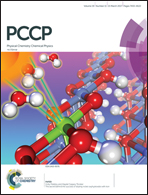Probing the shape of a graphene nanobubble†
Abstract
Gas molecules trapped between graphene and various substrates in the form of bubbles are observed experimentally. The study of these bubbles is useful in determining the elastic and mechanical properties of graphene and adhesion energy between graphene and the substrate, and manipulating the electronic properties via strain engineering. In our numerical simulations, we use a simple description of the elastic potential and adhesion energy to show that for small gas bubbles (∼10 nm) the van der Waals pressure is in the order of 1 GPa. These bubbles show universal shape behavior irrespective of their size, as observed in recent experiments. With our results, the shape and volume of the trapped gas can be determined via the vibrational density of states (VDOS) using experimental techniques such as inelastic electron tunneling and inelastic neutron scattering. The elastic energy distribution in the graphene layer which traps the nanobubble is homogeneous apart from its edge, but the strain depends on the bubble size; thus variation in bubble size allows control of the electronic and optical properties.



 Please wait while we load your content...
Please wait while we load your content...